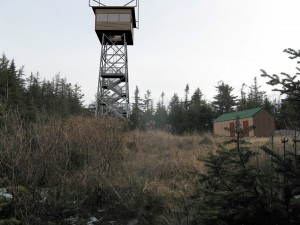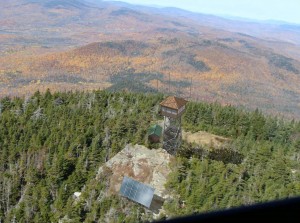Connecting Mt. Blue

To camouflage the new communications technology, the new tower will look like an older fire lookout tower and will include an observation deck for hikers. (Photo Courtesy Harris Corp.)
A Maine mountaintop is slated to be the site of a unique communications tower that combines a 1944-style structure with modern microwave technology. The planned Mt. Blue tower is part of Maine’s statewide communications consolidation project, which will incorporate the FCC’s narrowbanding mandate.
The problem with building a tower atop Mt. Blue is that the site is inside Mount Blue State Park — and the park dictates that there can be no structures there. However, there used to be a lookout fire tower on the site — so the Maine Office of Information Technology (OIT) is planning to camouflage the new communications technology in a replica of that tower, with the microwave dishes inside the cab and stick antennas attached outside.
Old Look, New Challenges
Shawn Romanoski, OIT’s director of radio operations, worked with a team from Harris Corp., the company Maine contracted to overhaul its communications, to design a structure that would look like a traditional lookout tower.
“We came up with significant challenges during planning,” he admits. “We were hiding the equipment in the cab, so we had to change some materials to allow signals to propagate through. And wind became an issue,” with designing a tower for a 3,000′ elevation.
“We had to anchor it at eight points instead of four. We also had to engineer and design hinged door panels to accommodate the microwave dishes, which are 6 feet in diameter.” Romanoski adds, “But it only took a week or 10 days for us to overcome obstacles like this.”
Maine discontinued the old fire towers around 1990, including the original Mt. Blue tower. A skeleton of that tower remains, and hikers “expect to climb it. So the new tower will include an observation deck,” says Tom Driscoll, OIT Radio Project Office, MSCommNet outreach coordinator. “You can’t get inside the cab, but you’ll be allowed to climb to the deck where you can get a 360-degree view.”
After the plans were complete, there was some back and forth with the Department of Conservation before approval. “Everyone sat down and worked through problems,” Romanoski says.
Local Buy-In
Part of the approval process was to present the tower plan at a public hearing. Approximately 45 people showed up and gave the plan overwhelmingly positive feedback. Part of the residents’ approval was an interest in increased safety. Bruce Farnham, manager of the Mt. Blue State Park and a volunteer firefighter in the town of Weld, explains, “There has always been a communications problem in this area. My fire department hopes that this new tower will improve things for us and for others in the county.”
And indeed, Franklin County services will co-locate on the OIT communications structure.

The new radio tower will have a minimal impact on the vegitation and surrounding environment, and will use solar panels to harness its primary power. (Photo Courtesy Harris Corp.)
Minimal Impact
Because the tower is being built in a state park, the impact of construction will be held to a strict minimum. “We’ll remove the least vegetation possible to create the footprint of the buildings,” Driscoll says. The site is a helicopter access point and has an existing landing spot. All materials and equipment will be brought in by helicopter.
“The solar array — the primary power source — is 32′ x 26′. To limit visibility to hikers, we left a line of trees at the top of the trail to screen the solar panels,” Driscoll explains. “And when you’re on the observation deck, you can see them, but they’re close to the tower so they don’t affect the view.”
The secondary power system is a propane-powered generator, which is programmed to run only at night, at 15-minute intervals. “We timed it so it won’t even interfere with sunrise or sunset hikers,” says Romanoski.
The plan was to break ground for the tower in November, but “the weather is not cooperating,” Romanoski says. “We still hope to start soon.”
Regardless, the state office is confident that they’ll meet the 2013 narrowbanding deadline. “Mt. Blue is one of 43 sites, and equipment is scheduled to be delivered to all sites in October 2012,” Romanoski says.
Asked if he would recommend this method of camouflaging new equipment in an “old” fire tower to other agencies, Romanoski replies, “Absolutely. In many instances, you wouldn’t be successful in requesting a conventional self-supporting tower. This is a very good trade-off. Though there are extra costs involved — engineering for load analysis, hooking to rock — these are all challenges that directly relate to cost.”
In Closing
Everyone involved in planning this unique communications tower is happy with the final outcome. “These projects obviously get driven from the top, but this one was different. It succeeded because we listened to the local authorities and citizens,” says Driscoll.
About the Author
Jane Jerrard lives in Chicago and writes regularly for FireRescue magazine.
Originally written for FireRescue Magazine/FirefighterNation.com. Copyright Elsevier Public Safety.


